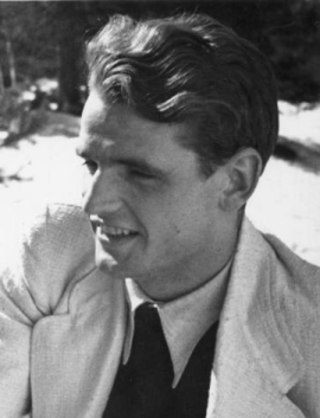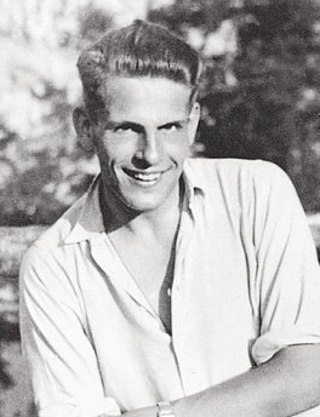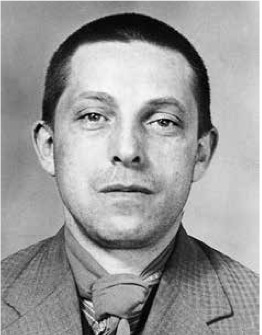
The White Rose was a non-violent, intellectual resistance group in Nazi Germany which was led by five students and one professor at the University of Munich: Willi Graf, Kurt Huber, Christoph Probst, Alexander Schmorell, Hans Scholl and Sophie Scholl. The group conducted an anonymous leaflet and graffiti campaign that called for active opposition to the Nazi regime. Their activities started in Munich on 27 June 1942; they ended with the arrest of the core group by the Gestapo on 18 February 1943. They, as well as other members and supporters of the group who carried on distributing the pamphlets, faced show trials by the Nazi People's Court ; many of them were imprisoned and executed.

Hans Fritz Scholl was, along with Alexander Schmorell, one of the two founding members of the White Rose resistance movement in Nazi Germany. The principal author of the resistance movement's literature, he was found guilty of high treason for distributing anti-Nazi material and was executed by the Nazi regime in 1943 during World War II.

Christoph Ananda Probst was a German student of medicine and member of the White Rose resistance group.

Wilhelm Guddorf was a Belgian journalist, anti-Nazi and resistance fighter against the Third Reich. Guddorf was a leading member of a Berlin anti-fascist resistance group that was later called the Red Orchestra by the Abwehr. Guddorf was the editor of the Marxist-Communist Die Rote Fahne newspaper.

Wilhelm "Willi" Graf was a German member of the White Rose resistance group in Nazi Germany. The Catholic Church in Germany included Graf in their list of martyrs of the 20th century. In 2017, his cause for beatification was opened. He was given the title Servant of God, the first step toward possible sainthood.

Hans Conrad Leipelt was an Austrian member of the White Rose resistance group in Nazi Germany.

Karl Ludwig Freiherr von und zu Guttenberg was a member of the German anti-Nazi resistance. He was executed in the aftermath of the failure of the 20 July plot to assassinate Adolf Hitler.
Traute Lafrenz Page was a German resistance activist who was a member of the White Rose anti-Nazi group during World War II.
The Saefkow-Jacob-Bästlein Organization was an underground German resistance movement acting during the Second World War, that published the illegal magazine, Die Innere Front.
The Bästlein-Jacob-Abshagen Group was a German resistance group that developed around the core members Bernhard Bästlein, Franz Jacob and Robert Abshagen. It fought the National Socialist (Nazi) regime from 1940 till the end of the war in 1945. It consisted of about 300 members in over 30 groups in Hamburg factories, making it the biggest regional Nazi resistance group in the history of Hamburg.

Franz Jacob was a German Resistance fighter against Nazism and a Communist politician.

Dagobert Biermann was a German Communist and resistance fighter against National Socialism. His son is German singer and former East German dissident Wolf Biermann. He was murdered in Auschwitz.

Dr. Herbert Michaelis was a German lawyer and Communist, and a member of the German Resistance during the Third Reich.
Katharina Jacob was a teacher and member of the German Resistance movement against National Socialism. She was married to Franz Jacob, a German Resistance fighter who was executed by the Nazis.

The Socialist Youth League of Germany was a youth organization in Germany. SJV was the youth wing of the Socialist Workers' Party of Germany (SAPD). SJV was founded in 1931. The organization was banned after the Nazi take-over 1933.
Rudolf Degkwitz was a German physician, an early member of the Nazi Party and a participant in the 1923 Beer Hall Putsch.
Erich Heins was a German communist and resistance fighter against the Nazis and a Nazi Victim.
Walter Hochmuth was a German politician in the Weimar Republic (KPD), resistance fighter during the Nazi regime and a diplomat of East Germany.

Martin Weise was a German journalist, member of the Communist Party of Germany (KPD) and a resistance fighter against the Nazis during World War II. From 1929 to 1934, Weiss published the socialist Die Rote Fahne newspaper. He was arrested and sent to a concentration camp until 1939. When he was released, he decided to resist and made contact with Wilhelm Guddorf and the Hamburg based group around Bernhard Bästlein and Robert Abshagen He became associated with an anti-fascist resistance group that was run by Harro Schulze-Boysen and Arvid Harnack, that was later called the Red Orchestra by the Abwehr.
People of the Saefkow-Jacob-Bästlein Organisation is a list of participants, associates and helpers of the Saefkow-Jacob-Bästlein Organization, which was one of the largest anti-Nazi resistance organisations that came into existence during World War II in Germany. It was formed in Berlin and had contacts to many other regions that hosted industrial manufacturing. It is therefore also referred to in the literature as the operational leadership of the Communist Party of Germany (KPD). However, it was not only communists among the groups of the Saefkov Jacob Bästlein organisation. The 506 known persons included about 200 before 1933 to the KPD, 22 to the Social Democratic Party of Germany (SPD) or to the Socialist Workers' Party of Germany (SAP) and around 200 were non-party; one in four was a woman. 160 men and women were unionized before 1933, more than 60 of them in the German Metal Workers' Union (DMV). The local or region is indicated for the people who worked outside Berlin and Brandenburg.











